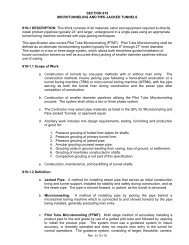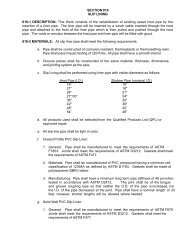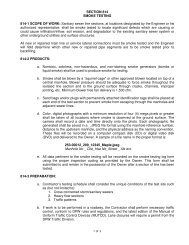Contents
Construction Management Plan - Baton Rouge Department of Public ...
Construction Management Plan - Baton Rouge Department of Public ...
- No tags were found...
You also want an ePaper? Increase the reach of your titles
YUMPU automatically turns print PDFs into web optimized ePapers that Google loves.
2. The length of exposure, and;<br />
3. The protection provided for the skin.<br />
• The skin and eyes are the most susceptible to UV damage. You need to be especially careful in<br />
the sun if you have:<br />
• Numerous moles, irregular moles, or large moles;<br />
• Freckles or burn before tanning;<br />
• Fair skin, or blond, red or light brown hair; or<br />
• Spend a lot of time outdoors.<br />
• When working outdoors, follow these five steps to protect against UV radiation and the adverse<br />
health affects it can cause:<br />
1. Wear Appropriate Clothing and Protection. Reduce UV radiation damage by wearing<br />
proper clothing:<br />
• Wear long sleeved shirts with collars, and long pants;<br />
• Wear clothing to protect as much of your skin as possible;<br />
• Wear clothing that does not allow visible light through it;<br />
• To determine if the clothing will protect you: Place your hand between the fabric and a<br />
light source. If you can see your hand through the fabric, the garment offers little<br />
protection against sun exposure;<br />
• Head protection should be worn to protect the face, ears, and neck. A wide brim hat is<br />
ideal because it protects the neck, ears, eyes, forehead, nose and scalp. Pith-style hard<br />
hats are available, as well as brim attachments for hard hats for additional protection. A<br />
baseball cap may not be appropriate depending on the hazards in the area. Baseball<br />
caps provide some protection for the front and top of the head, but not for the back of<br />
the neck or the ears where skin cancers commonly develop;<br />
• Wear UV-absorbent sunglasses or safety glasses. These should fit closely to the face.<br />
Wrap-around style glasses provide the best protection. Ideal sunglasses do not have to<br />
be expensive, but they should block 99 to 100% of UVA and UVB radiation. Check the<br />
label to make sure they do. Darker glasses are not necessarily the best. UV protection<br />
comes from an invisible chemical applied to the lenses, not from the color or darkness of<br />
the lenses;<br />
• Use “broad spectrum” sunscreen with at least 15 Sun Protection Factor (SPF). Experts<br />
recommend products with a SPF of at least 15. The number of the SPF represents the<br />
level of sunburn protection provided by the sunscreen. An SPF 15 blocks out 93% of the<br />
UV rays; an SPF 30 blocks out 97% of the UV rays. Products labeled “broad spectrum”<br />
block both UVB and UVA radiation. Both UVA and UVB contribute to skin cancer;<br />
• Apply sunscreen generously to all exposed skin surfaces at least 20 minutes before<br />
exposure, allowing time for it to adhere to the skin;<br />
• Reapply sunscreen at least every 2 hours, and more frequently when sweating or<br />
performing activities where sunscreen may be wiped off;<br />
• Waterproof sunscreens should be selected for use in or near water, and by those who<br />
perspire sufficiently to wash off non-waterproof products;<br />
• Check for expiration dates, because most sunscreens are only good for about 3 years.<br />
Store in a cool place out of the sun;<br />
GNV310133632156.DOC/090840008 A-29












